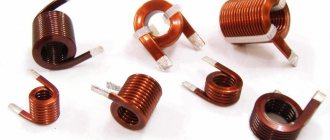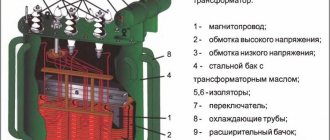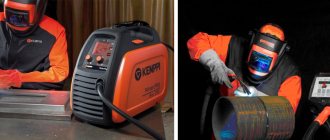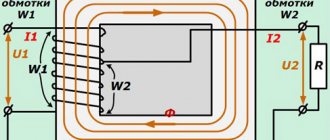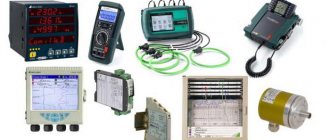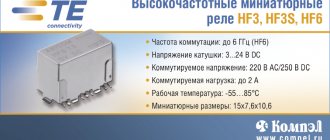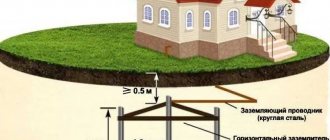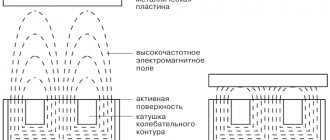Today we are interested in the simplest oscillatory circuit , its operating principle and application.
For useful information on other topics, go to our Telegram channel.
Oscillations are a process that repeats over time and is characterized by changes in system parameters around the equilibrium point.
The first thing that comes to mind is the mechanical vibrations of a mathematical or spring pendulum. But vibrations can also be electromagnetic.
By definition, an oscillatory circuit (or LC circuit) is an electrical circuit in which free electromagnetic oscillations occur.
Such a circuit is an electrical circuit consisting of a coil with inductance L and a capacitor with capacitance C. These two elements can be connected in only two ways - in series and in parallel. Let us show in the figure below an image and a diagram of a simple oscillatory circuit.
By the way! For all our readers there is now a 10% on any type of work .
By the way! For all our readers there is now a 10% on any type of work .
Parallel oscillatory circuit
Ideal oscillatory circuit
In the diagram, an ideal oscillatory circuit looks like this:
Where
L - inductance, Henry
C - capacitance, Farad
Real oscillating circuit
In reality, our coil has a decent loss resistance, since it is wound from wire, and the capacitor also has some loss resistance. Capacitance losses are very small and are usually neglected. Therefore, we will leave only one coil loss resistance R. Then the diagram of a real oscillating circuit will take this form:
Where
R is the circuit loss resistance, Ohm
L - inductance, Henry
C - capacitance, Farad
Application
Almost all power electrical engineering uses just such an oscillatory circuit, say, a power transformer. The circuit is also necessary for setting up the operation of a TV, capacitive generator, welding machine, radio receiver; it is used by the “matching” technology of television broadcast antennas, where you need to select a narrow frequency range of some of the waves used. The RLC circuit can be used as a band-pass filter, notch filter, for low-pass or high-pass distribution sensors.
Resonance is even used in aesthetic medicine (microcurrent therapy) and bioresonance diagnostics.
Operating principle of a parallel oscillating circuit
Let's connect a real parallel oscillatory circuit to the frequency generator
What will happen if we apply a current to the circuit with a frequency of zero Hertz, that is, direct current? It will calmly run through the coil and will be limited only by the loss resistance R of the coil itself. No current will flow through the capacitor, because the capacitor does not allow direct current to pass through. I wrote about this in the article: capacitor in direct and alternating current circuits.
Let's add frequency then. So, as the frequency increases, our capacitor and coil will begin to provide reactance to the electric current.
The reactance of the coil is expressed by the formula
and the capacitor according to the formula
You can read more about this in this article.
If you gradually increase the frequency, you can understand from the formulas that at the very beginning, with a smooth increase in frequency, the capacitor will have greater resistance than the inductor. At some frequency, the reactances of the XL coil and the XC capacitor will be equal. If you further increase the frequency, then the coil will already have greater resistance than the capacitor.
General information
An oscillatory circuit is an electrical circuit consisting of a capacitor and an inductor used to generate free electromagnetic oscillations in radio receivers and radio transmitters. This device is used as various filters (band-pass and notch). This radio element is used to adjust signals to increase or decrease amplitude. The main function of the circuit is frequency filtering.
The device has become widespread in the military sphere. Radar stations use noise reduction filters. The enemy uses various jammers that block target detection. The equipment includes a special device consisting of ordinary circuits, but with a core made of a special alloy. The interference is “filtered”, and the radar operator receives a complete picture of the air situation.
The device can also be used for automation. For example, aircraft include a frequency control unit. Its main elements are two circuits, which are tuned to only two frequencies - 760 and 840 Hz. They receive voltage with a frequency of 790 Hz from a special generator. The latter emits only 395 Hz. If the frequency deviates from the nominal value downward, then the reactance of one of the circuits decreases.
After this, the electronics of the unit are activated and a signal is issued to increase the generator speed. When the frequency value exceeds the rated value, the reactance of the other circuit increases. As a result of this, the automation is triggered, and another type of signal is received to reduce the generator speed.
Resonance of a parallel oscillatory circuit
A very interesting property of a parallel oscillatory circuit is that when XL = XC our oscillatory circuit will go into resonance . At resonance, the oscillatory circuit will begin to provide greater resistance to alternating electric current. This resistance is also often called the resonant resistance of the circuit and is expressed by the formula:
Where
Rres is the circuit resistance at the resonant frequency
L is the actual inductance of the coil
C is the actual capacitance of the capacitor
R - coil loss resistance
Device detuning
Detuning is the tuning of a circuit to a frequency other than the resonant one. The latter occurs when the frequency characteristics of the radio component and the generator coincide. In some devices this must be avoided. To obtain resonance, you need to use one of three methods of changing characteristics:
- generator frequency;
- inductance;
- containers.
The last two methods can be done simultaneously to achieve better results. Disorders are classified into three types: absolute, generalized and relative. The first is the difference between the frequencies of the circuit and the resonance. The generalized one is calculated using the ratio of reactance to active resistance. Relative is expressed as the ratio of absolute detuning to resonant frequency.
In addition, frustration can be positive and negative. In the first case, it is necessary that the generator frequency be greater than the circuit frequency. For negative, another condition must be met: the frequency of the generator is less than that of the circuit.
In some cases it is necessary to remove the resonant frequency. This operation is performed by changing the necessary characteristics of the electrical circuit “circuit - generator”. Very often capacitors with variable capacitance are used in the circuit , allowing it to be tuned. The capacitor is adjusted by changing the distance between its plates. This principle is very convenient, since to change the inductance of the coil, a core is needed that will be unscrewed.
However, there are radioelements of this type. In them, the capacitance is a constant value, and the inductance changes with the help of the core. The design feature of the latter is an ordinary ferrite bolt, which is screwed into a plastic housing. The wire is wound around the latter.
How to find the resonance of a parallel oscillatory circuit in practice
Okay, let's get to the point. We take the soldering iron in our hands and solder the coil and capacitor in parallel. The coil is 22 µH, and the capacitor is 1000 pF.
So, the real diagram of this circuit will be like this:
In order to show everything clearly and clearly, let’s add a 1 KOhm resistor in series to the circuit and assemble the following circuit:
We will change the frequency on the generator, and we will remove the voltage from terminals X1 and X2 and watch it on an oscilloscope.
It is not difficult to guess that the resistance of the parallel oscillatory circuit will depend on the frequency of the generator, since in this oscillatory circuit we see two radio elements whose reactance directly depends on the frequency, so we will replace the oscillatory circuit with the equivalent resistance of the circuit Rcon.
A simplified diagram would look like this:
I wonder what this circuit looks like? Is it a voltage divider? Exactly! So, remember the rule of the voltage divider: at a lower resistance, a smaller voltage drops, at a higher resistance, a larger voltage drops. What conclusion can be drawn in relation to our oscillatory circuit? Yes, everything is simple: at the resonant frequency, the resistance Rcon will be maximum, as a result of which a greater voltage will “drop” at this resistance.
We have a resistor calculator by color. The coolest collection.
Let's begin our experience. We increase the frequency on the generator, starting with the lowest frequencies.
200 Hertz.
As you can see, a small voltage “drops” on the oscillatory circuit, which means, according to the voltage divider rule, we can say that now the circuit has a low resistance Rcon
Adding frequency. 11.4 Kilohertz
As you can see, the voltage on the circuit has increased. This means that the resistance of the oscillatory circuit has increased.
Let's add another frequency. 50 Kilohertz
Notice that the voltage on the circuit has increased even more. This means his resistance has increased even more.
723 Kilohertz
Pay attention to the cost of dividing one square vertically, compared to past experience. There was 20 mV per square, and now it’s 500 mV per square. The voltage increased as the resistance of the oscillatory circuit became even greater.
And so I caught the frequency at which the maximum voltage on the oscillating circuit was obtained. Pay attention to the vertical division price. It is equal to two Volts.
A further increase in frequency causes the voltage to begin to drop:
We add the frequency again and see that the voltage has become even less:
Example solution
For the device, you need to calculate a circuit with a resonance frequency of 1 MHz. You can use the described formulas, however, radio amateurs made some calculations and proposed a more simplified version: L = (159.1 / f)^2 / C. For the circuit, you can take an approximate value of the capacitance of a flat-plate capacitor equal to 1000 pF. This parameter is indicated on the body.
In addition, the marking may contain the voltage for which it is designed. By substituting all the values into the formula, you can find out the inductance: L = (159.1 / 1)^2 / 1000 = 25 (µH). After this, you should calculate the number of turns N of the coil with frame diameter D according to the following ratio: N = 32 * ^(½). If we assume that D = 5 mm (can be taken from old circuits), then N = 32 * [25 / 5]^(½) = 72 (turns). However, as a basis, you can take a coil with a tuning ferrite core with the following parameters:
- length - 13-15 mm;
- diameter - 2.3-3.2 mm.
You can use the following ratio: N = 8.5 * L^(½) = 8.5 * 25^(½) = 43 (turns). The wire should be 0.1 mm in diameter. This indicator is measured using a caliper.
Thus, an oscillatory circuit is the simplest system for generating electromagnetic oscillations, the attenuation of which depends on the resonance frequency and the quality factor of the radio element.
Current resonance
So, let's say we have driven our oscillatory circuit into resonance:
What will the resonant current Ires be equal to? We calculate according to Ohm's law:
Ires = Ugen /Rres, where Rres = L/CR.
But the funny thing is that during resonance in the circuit, our own circuit current Icon appears, which does not go beyond the boundaries of the circuit and remains only in the circuit itself! Since I have a hard time with mathematics, I will not give various mathematical calculations with derivatives and complex numbers and explain where the loop current comes from during resonance. That is why the resonance of a parallel oscillatory circuit is called current resonance .
Quality factor of parallel oscillatory circuit
By the way, this loop current will be much greater than the current that passes through the loop. And do you know how many times? That's right, Q times. Q is the quality factor ! In a parallel oscillatory circuit, it shows how many times the current strength in the circuit Icon is greater than the current strength in the common circuit Ires
Or the formula:
If we also add loss resistance here, the formula will take the following form:
Where
Q - quality factor
R - loss resistance on the coil, Ohm
C - capacity, F
L - inductance, H
